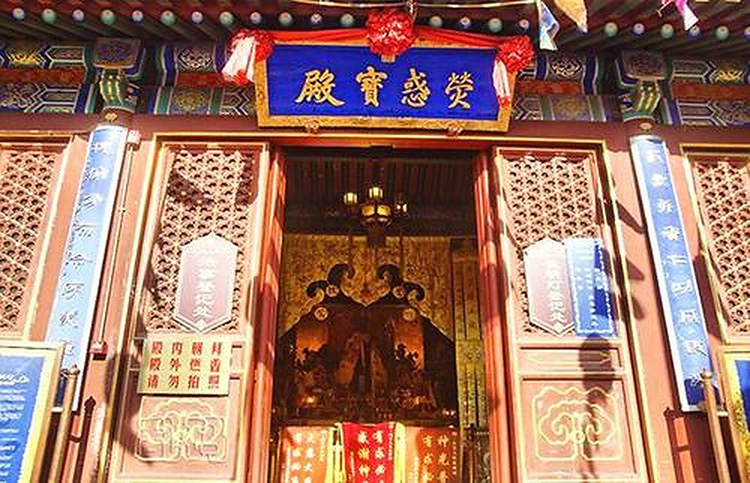Beijing Huode Zhenjun Temple: Historic Taoist Sanctuary at Shichahai Scenic Area
1. A Walk Through History
On the eastern shore of Beijing’s scenic Shichahai, stands the ancient Huode Zhenjun Temple, also known as the “Fire God Temple.” Founded in 632 AD during the Tang Dynasty, this imperial Taoist temple is nearly 1,400 years old, predating even the founding of Beijing as a capital. It is the oldest and largest Fire God Temple in the city, and one of Shichahai’s most important cultural landmarks. Strolling here, you’ll feel the blend of centuries-old Taoist culture with the charm of old Beijing life.
The temple has been restored and expanded through the Yuan, Ming, and Qing dynasties. During the Ming Dynasty, Emperor Wanli expanded it after palace fires, gifting the temple glazed tiles to “suppress fire”. In the Qing Dynasty, Emperor Qianlong renovated parts of the temple with yellow tiles, cementing its status as a royal Taoist sanctuary.
Traditionally overseen by Taoist priests of the Zhengyi sect, the temple reportedly hosted successive Celestial Masters during imperial visits. Locals say, “The Fire God Temple existed before the city of Beijing,” highlighting its deep cultural roots.

2. Architecture and Artistic Wonders
Huode Zhenjun Temple follows a classic central-axis layout, forming three sequential courtyards. Its main gate faces Dianmen Outer Street, featuring yellow-glazed tiles and green trim—a clear signal of imperial rank.
The Main Hall (Huo Zu Hall or Yinghuo Treasure Hall) enshrines the Southern Fire Deity (Yinghuo Star Lord). Inside, visitors are mesmerized by a gilded octagonal coffered ceiling adorned with dragons and lotus motifs, a rare masterpiece in Beijing. Originally, the hall displayed a plaque and couplets written by Emperor Qianlong, further emphasizing its royal heritage.
Other halls are richly adorned:
- Lingguan Hall (South) – houses the Taoist guardian deity Wang Lingguan.
- Wanshou Jingming Pavilion (North, Jade Emperor Pavilion) – dedicated to the Jade Emperor.
- Zhenwu Hall – dedicated to the True Warrior Deity.
- Side halls include Yuelao Hall (Matchmaking Deity), Cai Shen Hall (Wealth God), and Cihang Hall, catering to diverse devotional needs.

3. Religion and Cultural Life
The temple hosts daily morning and evening rituals, with the most important celebration on the 22nd day of the 6th lunar month, marking the Fire Ancestor’s Birthday, historically honored by imperial officials.
As a thousand-year-old sanctuary, the temple fuses imperial ritual and folk belief. Even amidst the busy streets, the temple exudes serenity. Standing inside, visitors can feel the incense-laden spiritual aura while gazing out at the sparkling waters of Shichahai, capturing the harmonious mix of religion and old Beijing charm.

4. Visitor’s Guide
Dress & Etiquette
- Wear modest attire; avoid revealing clothes.
- Keep quiet and respect the sacred space.
- Do not touch statues or relics.
- When photographing, avoid capturing the front of deities directly.
Recommended Route
Enter through the eastern gate, pass the colorful “Shouguo Shanlin” arch, follow the central axis to Lingguan Hall, Huo Zu Hall, then proceed to Zhenwu Hall and Wanshou Jingming Pavilion. Explore the side halls if time permits. Total visit: 1–2 hours.
Best Time to Visit
All seasons are suitable, with spring and autumn offering the most comfortable weather. To witness special rituals, visit around the 22nd day of the 6th lunar month for the Fire Ancestor’s birthday celebration.

5. Practical Information
- Opening Hours: 8:30 AM – 5:00 PM (year-round; may adjust for festivals or rituals)
- Tickets: Free, no reservation required
- Transport:
- Subway: Line 8, Shichahai Station, Exit A, ~10-minute walk along Qianhai East
- Bus: Routes 82, 124 to Dianmen Outer Street, ~5-minute walk
- Car: Navigate to “Shichahai Huode Zhenjun Temple”; parking is limited—public transport recommended
Guided Services
- Foreign-language guides can be arranged via advance booking in Beijing
Nearby Attractions
The temple is adjacent to Shichahai Scenic Area, within walking distance of Yandai Xiejie, Drum Tower, Nanluoguxiang, and Prince Gong’s Mansion, perfect for half-day or full-day exploration.

Whether you are a cultural enthusiast or seeking a quiet retreat, Huode Zhenjun Temple offers a memorable journey through Beijing’s spiritual and historical landscape, where ancient Taoist traditions meet the tranquil beauty of Shichahai.


